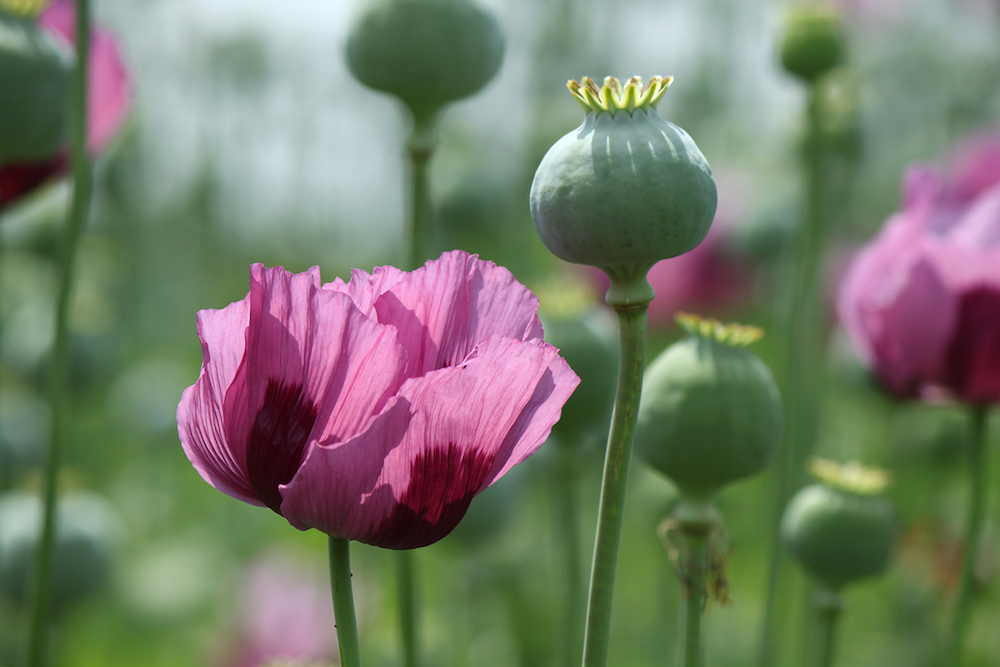Massive Poppy Bust: Why Home-Grown Opium Is Rare

Editor's Note: This story was updated at 11:20 a.m. E.T. on Tuesday June 13
A North Carolina man was arrested last month when police discovered an acre of opium poppies growing in his yard.
The alleged grower, Cody Xiong, faces a rare charge in the United States. Despite a raging opioid epidemic in the country, fields of home-grown opium are rare. The sheriff in the North Carolina case said the discovery was only the second time the plant had been found growing in the United States this year, WBTV reported.
There are two big reasons for this lack of agricultural entrepreneurship: effective U.S. law enforcement and the ease of importing heroin made from opium poppies grown elsewhere, said H. Douglas Wankel, a former assistant administrator and chief of operations in the Drug Enforcement Administration (DEA). Growing enough poppies to make heroin in the United States doesn't make much economic sense compared to importing the drug from more lawless regions, Wankel said. Compared to marijuana, opium poppies are more conspicuous and harder to process, and carry much harsher penalties for growing. [10 Interesting Facts About Heroin]
"It's very labor-intensive," Wankel told Live Science.
How heroin is made
Heroin comes from the gum of opium poppies (Papaver somniferum). These flowers aren't difficult to grow, Wankel said. They thrive in temperate climates and are probably native to the Mediterranean, but they can be grown in subtropical and tropical regions as well.
Papaver somniferum plants are the same ones that make poppy seeds, which are legal and widely available from many seed catalogues. Growing these seeds, though, puts gardeners in something of a legal gray area. The DEA includes "opium poppy" and "opium straw" (the plant, minus its seeds) on the agency's list of Schedule II drugs, meaning that technically, the DEA could press charges against anyone growing that variety in their backyard.
Get the world’s most fascinating discoveries delivered straight to your inbox.
Practically, the agency usually doesn't do this, but in 1997, food writer Michael Pollan wrote an article for Harper's Magazine on the potential legal complications of planting opium poppies. In the article, he described the case of a counterculture writer Jim Hogshire, who was arrested for possessing a handful of dried poppy bulbs he'd bought at a florist. Felony charges against Hogshire were eventually dropped in a plea bargain that left him with a misdemeanor on his record, a $100 fine, 100 assigned hours of community service and a year of probation, The New York Times reported. Pollan found that, at the time, the DEA was quietly trying to urge garden companies not to sell Papaver somniferum seeds.
It's undeniably illegal to grow opium poppies with the intent to make opium tea, heroin or any other intoxicating substance. The processing itself is not challenging technically, though it does involve more labor than, say, harvesting marijuana: The grower must use razors to slice the bulb under the poppy plant in the morning and then wait all day for drops of thick, white opium gum to ooze out. This gum is then scraped and processed with water and solvents to extract a morphine solution. Additional chemicals are added to precipitate solid morphine out of this liquid.
This morphine solid is then dried, heated and processed with several other chemical additives to make heroin. Crude processing creates black-tar heroin, which is mostly smoked or snorted. Additional purification steps are needed to make white-powder heroin, which is injectable.
At-home heroin?
The first problem for do-it-yourself growers is that it would be hard to plant enough poppies to make an appreciable amount of drug without being noticed, Wankel said. The plants can grow more than 3 feet (0.9 meters) tall and are topped with brightly colored flowers that look a bit like frilly tulips. Any reasonably sized plot of these flowers would easily stand out in terrestrial or aerial surveys done by law enforcement agencies, Wankel said.
In one case in Oregon, a forest patrol officer stumbled across a plot of poppies in a remote area. Initially, he went to check them out because he thought the scarlet blooms would make a nice bouquet for his wife. On closer inspection, he realized the plants were suspicious.
Though opium yields vary based on growing conditions, 2.5 acres (1 hectare) of poppies typically produce between 17.6 and 33 lbs. (8 to 15 kilograms) of raw opium, according to the book "Opium: A History" (St. Martin's Griffin, 1999). Estimated yields of heroin from raw opium are between 6 percent and 10 percent. Thus, the acre of poppies found in North Carolina would yield a little more than 13 lbs. (6 kg) of raw opium and 1.3 lbs. (0.6 kg) of heroin in a full growing season in the best of circumstances.
That's not nothing; CBS News reported in 2014 that heroin was going for $60,000 per kg (2.2 lbs.) in New York City, though actual prices vary based on purity and supply. But the value of Xiong's plants is nowhere near the $500 million that the Catawba County Sheriff's Office claimed the poppy bust was worth.
The penalties are stiff for growing poppies in the United States. According to WBTV, Xiong has been levied an illegal drug tax of $186 million for growing the plants. He has also been charged with manufacturing and trafficking by possession. North Carolina has a mandatory minimum sentence of 225 months, or almost 19 years, in prison for trafficking more than 28 grams (about 1 ounce) of heroin. (For comparison, you have to traffic more than 10,000 lbs., or 4,500 kg, of marijuana to get a mandatory minimum of 175 months, or 14 and a half years, in prison in the state.)
Given the United States' established law enforcement and stiff penalties for manufacturing heroin, most of the country's supply of the drug comes from Latin America, Wankel said. Countries in which the government is ineffective are the most fertile ground for large-scale poppy cultivation, he said.
As of 2015, the United Nations Office on Drugs and Crime (UNODC) estimated that there are more than 690,00 acres (280,000 ha) of land under cultivation for opium poppies worldwide, with approximately 330 tons (300 metric tons) of heroin produced. Afghanistan is the world capital of opium; estimates peg its share of the global opium production at between 75 and 85 percent, with an estimate of nearly 500,000 acres (200,000 ha) under cultivation as of 2016. Most of Afghanistan's production ends up on the black market in Russia, Asia and Europe, but smaller heroin producers in Myanmar and Laos also feed those markets.
Even in these countries, though, profits flow to the drug cartels that process and move heroin, not the people who grow the poppies. Vice reported in 2016 that Mexican farmers could sell a kg of opium paste for $870. The amount of heroin in that quantity of paste could, once processed, fetch more than $4,500 on the street in the United States. In Afghanistan, the UNODC estimates the total export value of the opium trade at $4 billion, only $1 billion of which goes to the farmers who grow opium poppies. The rest flows to traffickers and warlords, along with government officials who look the other way as poppy blooms nod in the fields.
Thorny problem
The problem of heroin addiction goes beyond the drug itself. Overprescription of legal opioid drugs — along with less-than-upstanding doctors and pharmacists who run "pill mills" that prescribe painkillers freely — has helped create widespread addiction to opioids, said Theodore Cicero, a professor of psychiatry at Washington University School of Medicine in St. Louis who has researched opioid abuse. (Though only 4 percent of people who misuse prescription pills go on to use heroin, nearly 80 percent of people who become addicted to heroin had used prescription pills first, according to the National Institute on Drug Abuse.)
People often turn to the drugs as a form of escape or an (extremely dangerous) do-it-yourself mental health treatment, Cicero said.
"It meets a lot of needs for people to escape medical conditions they have," he said.
As the depth of the problem has become apparent, the Centers for Disease Control and Prevention (CDC) has tightened the guidelines for prescribing opioids for chronic pain. This has taken some of the pill supply off the black market, Cicero said, but people who are addicted have turned to heroin instead.
"As you reduce the supply of prescription drugs, addicts aren't going to stop using," Cicero told Live Science. "Rather, they're going to switch to something else."
Heroin is typically much cheaper than black-market prescription drugs anyway, Cicero said. Making matters worse, opioid users gradually develop a tolerance to the drug, meaning they need more and more to get high. In the quest for customers, dealers often sell heroin mixed with even higher-octane opioids, like fentanyl. Fentanyl is 100 times more potent than morphine, according to the UNODC. According to the DEA, most black-market fentanyl in the United States is illegally manufactured, mostly in China, rather than stolen from the pharmaceutical industry.
As more potent drugs have appeared on the market, overdose deaths have spiked. Since 1999, according to the CDC, opioid overdose deaths have quadrupled. In 2015, the agency reported that 33,091 Americans died of a drug overdose involving a prescription or illegal opioid drug.
"There's a fine line between the next best jolt," Wankel said, "and the death jolt."
Editor's Note: This story was edited to note that Cody Xiong faces charges of manufcaturing and trafficking by possession, but has not yet been convicted of a crime.
Original article on Live Science.

Stephanie Pappas is a contributing writer for Live Science, covering topics ranging from geoscience to archaeology to the human brain and behavior. She was previously a senior writer for Live Science but is now a freelancer based in Denver, Colorado, and regularly contributes to Scientific American and The Monitor, the monthly magazine of the American Psychological Association. Stephanie received a bachelor's degree in psychology from the University of South Carolina and a graduate certificate in science communication from the University of California, Santa Cruz.


